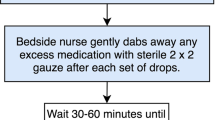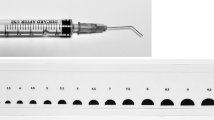Abstract
Objective:
Evaluate physiological and behavioral pain responses of premature infants following instillation of mydriatic eyedrops for retinopathy of prematurity (ROP) examinations. While burning and stinging occurs in older patients, the infant pain response is not well characterized.
Study Design:
Vital sign and video monitor recorded infant responses before, during and after mydriatic (tropicamide 1%, phenylephrine 2.5%) administration upon first ROP exam. Two masked observers graded Premature Infant Pain Profile (PIPP) scores immediately before and following eyedrop administration. Scores <7 indicate no/minimal pain, 7 to 12 slight/moderate, >12 severe.
Result:
Twenty infants had mean premydriatic PIPP score 3.6 (s.d. 1.6), mean postmydriatic score 5.7 (s.d. 3.4), mean change 2.1 (s.d. 3.4) (P=0.01). One (5%) had premydriatic PIPP score ⩾7, seven (35%) post scores ⩾7 (P=0.07) with one >12.
Conclusion:
Mydriatic drops cause a clinically significant pain response in one-third of infants. Non-pharmacological supportive measures are recommended for all infants until predictive factors are defined.
This is a preview of subscription content, access via your institution
Access options
Subscribe to this journal
Receive 12 print issues and online access
$259.00 per year
only $21.58 per issue
Buy this article
- Purchase on Springer Link
- Instant access to full article PDF
Prices may be subject to local taxes which are calculated during checkout

Similar content being viewed by others
References
Laws DE, Morton C, Weindling M, Clark D . Systemic effects of screening for retinopathy of prematurity. Br J Ophthalmol 1996; 80 (5): 425–428.
Belda S, Pallas CR, De la Cruz J, Tejada P . Screening for retinopathy of prematurity: is it painful? Biol Neonate 2004; 86 (3): 195–200.
Kirchner L, Jeitler V, Pollak A, Müllner-Eidenböck A, Weinzettel R, Kraschl R . Must screening examinations for retinopathy of prematurity necessarily be painful? Retina 2009; 29 (5): 586–591.
American Academy of Pediatrics Committee on Fetus and Newborn, American Academy of Pediatrics Section on Surgery, Canadian Paediatric Society Fetus and Newborn Committee, Batton DG, Barrington KJ, Wallman C . Prevention and management of pain in the neonate: an update. Pediatrics 2006; 118 (5): 2231–2241.
Gal P, Kissling GE, Young WO, Dunaway KK, Marsh VA, Jones SM . Efficacy of sucrose to reduce pain in premature infants during eye examinations for retinopathy of prematurity. Ann Pharmacother 2005; 39 (6): 1029–1033.
Marsh VA, Young WO, Dunaway KK, Kissling GE, Carlos RQ, Jones SM . Efficacy of topical anesthetics to reduce pain in premature infants during eye examinations for retinopathy of prematurity. Ann Pharmacother 2005; 39 (5): 829–833.
Mitchell A, Stevens B, Mungan N, Johnson W, Lobert S, Boss B . Analgesic effects of oral sucrose and pacifier during eye examinations for retinopathy of prematurity. Pain Manag Nurs 2004; 5 (4): 160–168.
Samra HA, McGrath JM . Pain management during retinopathy of prematurity eye examinations: a systematic review. Adv Neonatal Care 2009; 9 (3): 99–110.
Sun X, Lemyre B, Barrowman N, O’Connor M . Pain management during eye examinations for retinopathy of prematurity in preterm infants: a systematic review. Acta Paediatr 2010; 99 (3): 329–334.
Hassler-Hurst J, Wadham C, Rayman G . A double-blind study comparing 0.5% and 1% tropicamide for annual retinal screening in diabetic adolescents. Diabet Med 2004; 21 (5): 434–439.
Rush R, Rush S, Nicolau J, Chapman K, Naqvi M . Systemic manifestations in response to mydriasis and physical examination during screening for retinopathy of prematurity. Retina 2004; 24 (2): 242–245.
Ballantyne M, Stevens B, McAllister M, Dionne K, Jack A . Validation of the premature infant pain profile in the clinical setting. Clin J Pain 1999; 15 (4): 297–303.
Pasero C . Pain assessment in infants and young children: Premature Infant Pain Profile. Am J Nurs 2002; 102 (9): 105–106.
Stevens B, Johnston C, Petryshen P, Taddio A . Premature Infant Pain Profile: development and initial validation. Clin J Pain 1996; 12 (1): 13–22.
Acknowledgements
This work was supported by NIH K12-EY015398, NIH P30 EY01583-26 and the NIH Loan Repayment Program.
Disclaimer
The sponsor had no role in the study design; collection, analysis and interpretation of data; writing of the report; or decision to submit the manuscript for publication.
Author information
Authors and Affiliations
Corresponding author
Ethics declarations
Competing interests
The authors declare no conflict of interest.
Rights and permissions
About this article
Cite this article
Cohen, A., Cook, N., Harris, M. et al. The pain response to mydriatic eyedrops in preterm infants. J Perinatol 33, 462–465 (2013). https://doi.org/10.1038/jp.2012.149
Received:
Revised:
Accepted:
Published:
Issue Date:
DOI: https://doi.org/10.1038/jp.2012.149
Keywords
This article is cited by
-
Reducing discomfort of eye drops prior to retinal examination in the neonatal intensive care unit
Journal of Perinatology (2020)
-
Intranasal fentanyl for pain management during screening for retinopathy of prematurity in preterm infants: a randomized controlled trial
Journal of Perinatology (2020)
-
Efficiency and safety of phenylephrine and tropicamide used in premature retinopathy: a prospective observational study
BMC Pediatrics (2019)
-
Differential effects of the retinopathy of prematurity exam on the physiology of premature infants
Journal of Perinatology (2019)
-
N-terminal B-type natriuretic peptide urinary concentrations and retinopathy of prematurity
Pediatric Research (2017)



